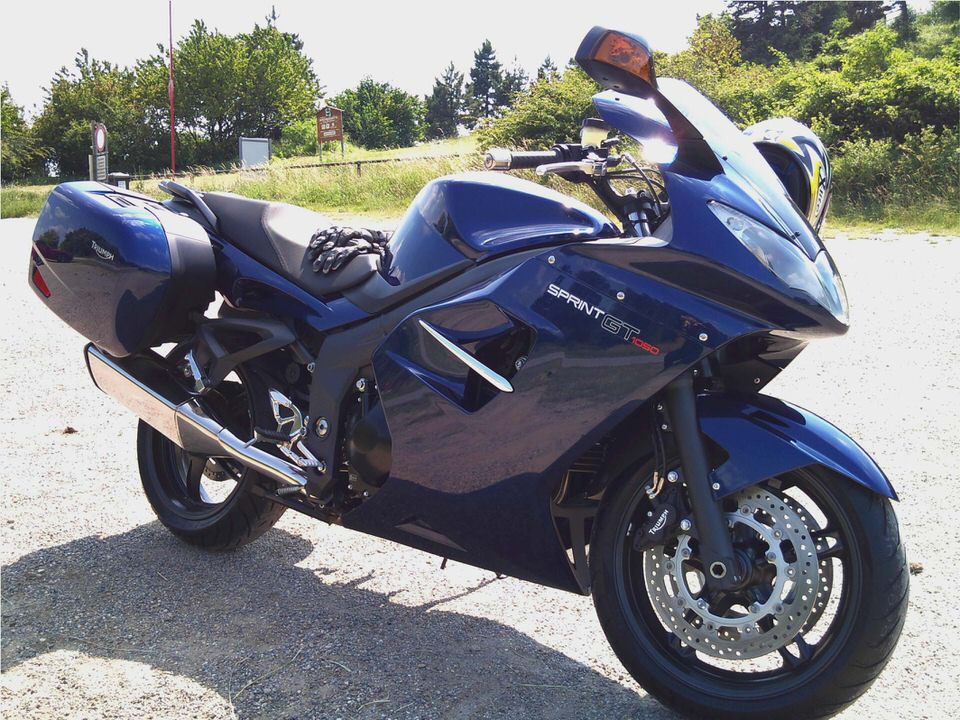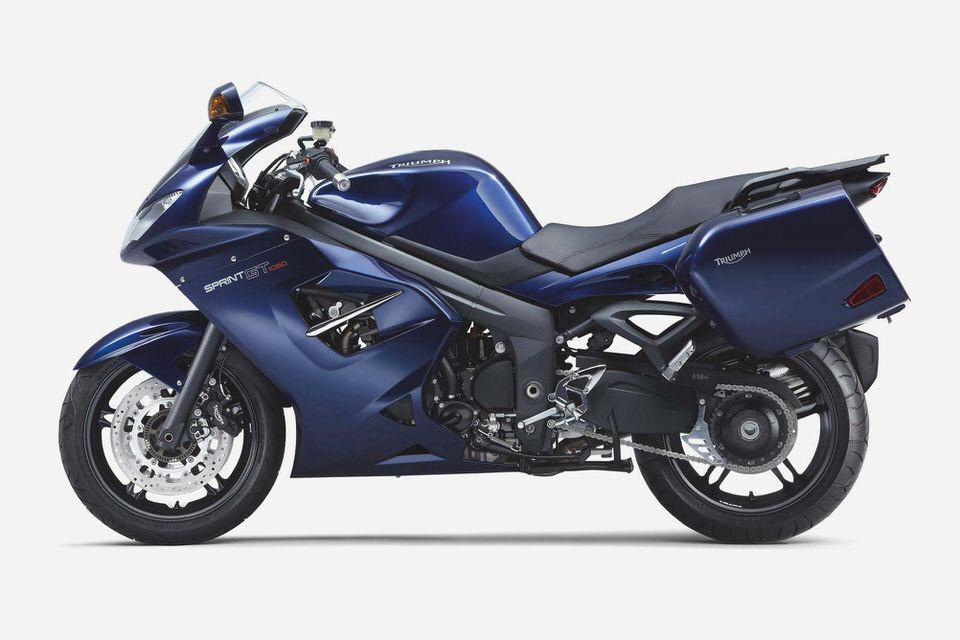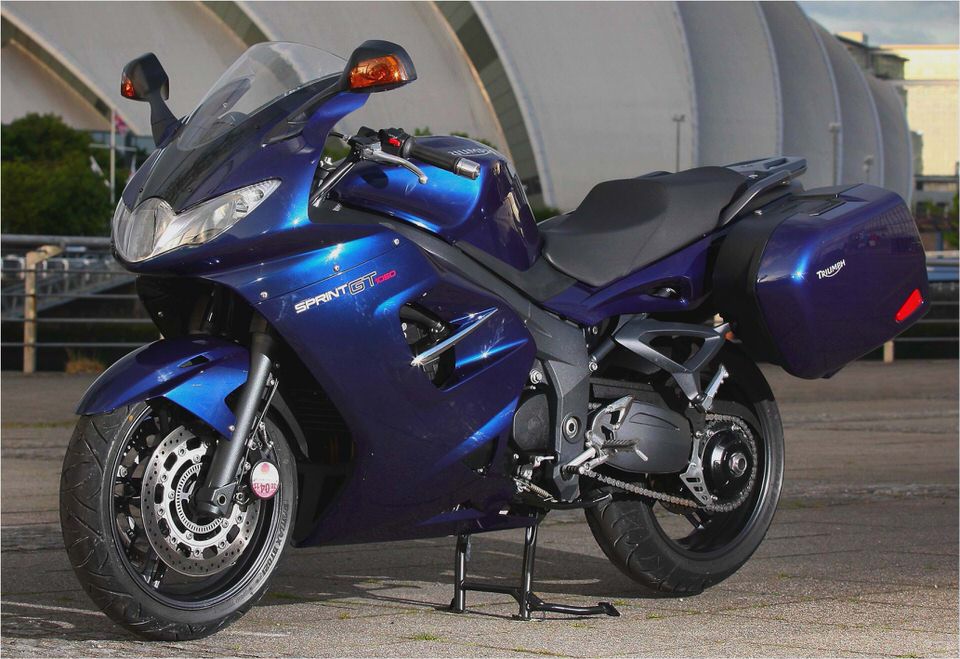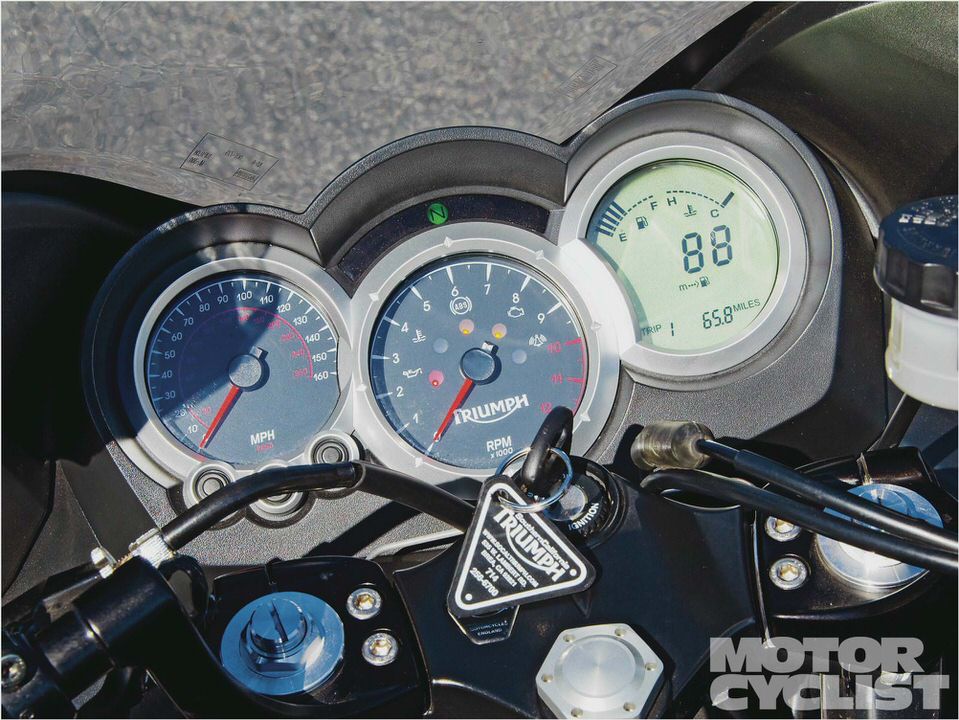
Triumph Sprint GT 2011 Review
Following a design path not unlike many other products catering to perceived demands for increased amenities and comfort, Triumph has enlarged the waistline of its Sprint 1050cc Triple for 2011.
The formerly designated Sprint ST (Sport Tourer) has now evolved into the 2011 Sprint GT (Grand Tourer). In becoming so, it delivers more cargo room and a plusher ride, while not losing much of its edge as a respectable canyon carver with bags.
The newly aggrandized model achieves its status in part by a 3.2-inch longer wheelbase (60.5-inches compared to a previous 57.3 inches), while offering updated styling to modernize the ST’s five-year-old design. The penalty for the new Sprint’s stretching and aesthetic sharpening is an additional 60 lbs – a more than 10% curb weight increase over its predecessor, now at 591 lbs full of fuel.
Triumph says the retuned version of the same fuel-injected three-cylinder engine that powered the ST now makes 5 more hp (128 hp vs. 123 hp). Claimed torque is increased by just under 4 ft-lbs to 79.7 ft-lbs, and now comes in at 6300 rpm — 1200 rpm sooner than on the ST.
Tidy details abound. The black-finished cast bits, and polished pieces complement the single-sided swingarm. The ignition key detaches the one-piece saddle.
Triumph says it has tipped the balance more toward “touring” in the sport-touring equation. Although we’re not overawed by the extra bulk with only some extra muscle to push it, we’ll still say that the bike works very well as the sporting tourer it’s intended to be, and we really like it.
Improvements include a stainless steel side-mounted muffler, instead of the signature three-pipe underseat exhaust that, while stylish, caught criticism by some for cooking the rider.
The GT’s wide, mildly stepped saddle provides all-day comfort and accommodates a variety of riders, although its claimed 32.1-inch height is pessimistic. “My inseam measures about 32 inches,” says Duke, “and there’s no way I can flat-foot the Sprint at a stop.” Coupled with a sufficiently broad and well-finished fairing, this still-potent bike is a mile eater.
A Sprint rider has a greater reach for the bars than its larger sport-touring rivals like the Yamaha FJR1300 and Kawi Concours 14, but ergos are nonetheless reasonably upright. The relatively tall seat height allows a comfortable amount of legroom despite the moderately rear-set, rubber-topped footpegs.
The alloy perimeter frame – tastefully finished in black and accenting nicely against black wheels and other black pieces – rides rock steady, and is coupled with a conventional Showa 43mm cartridge fork. Canted at a steep 23.5-degree rake and providing 84mm trail, the preload-adjustable fork has dual-rate springs, and, while simple, it is effective.
Out back is a monoshock that’s easily adjusted for preload by a large, right-side-mounted knob. The overall ride is quite plush on the freeway, and the fairing effectively deflects wind to shoulder height.
The single-sided cast alloy swingarm with eccentric chain adjuster, plus other castings, machined bits, hardware, and overall fit and finish are a pleasing sight to those who appreciate attention to detail.
This knob adjusts the rear spring preload.

Front Nissin four-pot calipers clamping 320mm rotors, and matching dual-piston rear caliper putting the squeeze to a 255mm rotor, are strong and reliable. Braided brake lines provide good feedback. The anti-lock system has a fairly high threshold up front, but intervention comes up easily from the rear.
One nitpick in this department is the rather long reach to the front brake lever. Both the front brake and clutch lever are adjustable to four positions, but there is a significant disparity in reach between the two. Even large hands have a longish reach to the brake lever when set to the shortest position.
Less easy to criticize, but also not utopian, is the 5.3-gallon fuel tank. Triumph claims about 200 miles per tank-full. Our testing confirmed this could be possible, but aggressive solo riding will tip this to closer to 170 miles or less. This is not so bad, and a lot of riders will be satisfied with this.
Even so, we’d have liked to have seen a 6-gallon tank on a bike with this long-legged two-up potential. However with its curb weight already knocking on the back door of 600 lbs, and perhaps other design considerations, the fuel capacity is what it is.
Another issue we’d observe is with the headlights. The Sprint ST was known to have only so-so illumination. Triumph says the Sprint GT’s halogens replacing the projector setup on the previous model are better, and we agree. However, they are only okay. The twin low beams on either side leave dim spots in the beam pattern, and have only adequate peripheral coverage (for cornering or to spot animals crossing the road, etc.).
The cycloptic center-mounted high beam gives good illumination of trees and overhead signs on the highway, but does little to fill in the voids left by the low beams or add to the side view. We think one high-beam bulb for two low beams is inadequate for a high-speed tourer, and believe more lighting might have been had by better engineered use of reflector space and other lighting technology now available.
Cockpit view: Instruments are functional. Polished handlebar weights roll freely when twisted. Hitting the red right-side kill button shuts off the electricity to the instruments but leaves headlights on.
Note lockable right side compartment in fairing. Very handy.



- Norton Villiers Triumph – Wikipedia, the free encyclopedia
- Kawasaki W650 And Triumph Legend TT – Counterbalancer – Motorcyclist Magazine…
- Triumph America No Baffles
- Triumph Sprint ST
- 2005 Triumph Rocket III First Ride – Motorcycle USA

